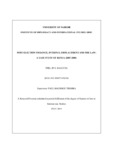| dc.description.abstract | History is littered with situations of forced migration, for whatever reason, since the beginning of
time and throughout human existence. In many cases, it is mother earth herself who wreaks
havoc on her inhabitants through natural calamities forcing them to move from their customary
abodes. Little, if anything, can be done to counter displacement caused by floods, earthquakes, or
even volcanic eruptions.
It is a far more curious affliction when the displacement of persons is, often violently, inflicted
by their fellow human beings. Is it our innate instinct for survival? Is it our constant conflict over
resources? Or have we merely succumbed to base (re)actions fuelled by greed, fear and hatred? It
is possible to have a cerebral discussion of the phenomenon of internal displacement and that is
what this research paper endeavours to do.
If it is agreed that certain entities - in this case states - are principally responsible for the welfare
and security of their people, then we must ask questions when they fail to protect citizens from
forced migration. In so doing, one can interrogate the strength of the unit responsible i.e. the state
and the efficiency of the structures and systems put in place to prevent internal displacement.
Only then can we begin to deal with the stupefying realization that internally displaced persons
have overtaken refugees and are now in excess of 50 million worldwide | en_US |

